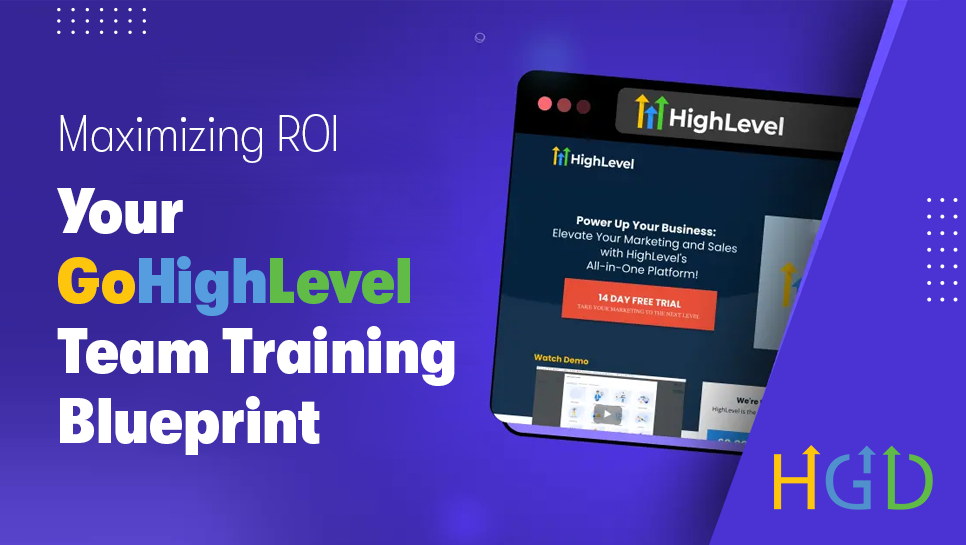
Companies reach out to robust all-in-one platforms such as GoHighLevel with a vision of combining their sales, marketing, and customer management. But what should be the route to productivity instead becomes the bottleneck of complexity. Teams are bogged down by the vast array of features. Hold on too tightly to old ways of working, or simply get bewildered. And while adoption stalls? Organizations see hard-won investments and Potential disappear through the cracks.
The key is not merely in acquiring the correct software but in getting your staff trained to utilize it to the max. GoHighLevel is of massive value, but only if your staff can tap into it. In the sections below, we'll walk you through an actionable plan to train your team on GoHighLevel. So that you can get maximum ROI and make operations less cumbersome.
1. Start with Clear Goals and Use Cases
Before jumping into training, define why you are implementing GoHighLevel. Is lead generation your priority? Client communication automation? Reporting simplification? Or all of them? By correlating the platform's functionalities with certain business goals? You establish context for your team. For example:
- Marketing teams may need to master funnels, campaigns, and automation workflows.
- Sales teams should focus on pipelines, opportunity tracking, and SMS/email follow-ups.
- Client service teams might prioritize dashboards, reporting, and appointment scheduling.
When goals are clear, training becomes focused rather than overwhelming.
2. Break Training into Digestible Modules
One of the most frequent blunders companies make is attempting to educate their staff on all things simultaneously. GoHighLevel is an exhaustive platform, and a "one-day crash course" is unlikely to stick. Rather, implement a modular training program. Dissect training into bite-sized chunks, such as:
- CRM & Pipelines – Managing leads, deals, and tracking sales activity.
- Automation & Workflows – Setting up triggers, campaigns, and follow-up sequences.
- Funnels & Websites – Building landing pages and forms for lead capture.
- Reputation & Reviews – Monitoring and managing client feedback.
Each module should build on the last, gradually boosting your team’s confidence and competence.
3. Use a “Hands-On First” Approach
Theoretical walkthroughs are useful, but hands-on practice drives retention. Encourage your team to learn by doing rather than passively listening. For example:
- When teaching pipelines, ask each sales rep to build their own test pipeline.
- During automation training, have marketing staff design a simple follow-up campaign.
- When covering reporting, let team members pull live dashboards with your business data.
This approach not only makes the training more engaging but also ensures team members apply skills immediately in real scenarios.
4. Leverage GoHighLevel’s Built-In Resources
GoHighLevel also offers a treasure trove of knowledge base articles. Video tutorials and community forums. Have your staff use these materials as part of their continuous learning process.
Also, assign "homework" between classes, such as watching an automation tutorial or studying a funnel build test. Self-directed learning complements in-class or live training. Supporting a culture of ongoing improvement.
5. Designate Internal Champions
All your team members may not pick up the learning at the same rate. An intelligent move is to appoint internal champions. Team members who understand the system in double-quick time and can serve as peer mentors. These champions can:
- Help answer day-to-day questions.
- Share tips and shortcuts.
- Lead refresher sessions for new hires.
This minimizes bottlenecks and avoids overdependence on managers or third-party consultants. Your organization becomes autonomous in handling and growing GoHighLevel over time.
6. Create Standardized Workflows and SOPs
Training should not only address the application of GoHighLevel. But also establish standard processes. Without standard operating procedures (SOPs), different members of the team can utilize the system differently. Resulting in errors or miscommunication. Document workflows such as:
- How leads are entered into the CRM.
- When and how automations are triggered.
- Steps for reporting on campaign performance.
Having SOPs in place ensures that fresh recruits ramp up fast and current employees maintain best practices. Keeping operations regular and predictable.
7. Track Progress and Encourage Feedback
Training is not an event, it's an ongoing process. Monitor adoption by tracking metrics such as:
- Pipeline updates per sales rep.
- Campaign execution rates.
- Customer engagement and conversion improvements.
Also, gather team feedback. Ask:
- Which features are still confusing?
- What processes feel repetitive or inefficient?
- What would make their work easier inside the platform?
This feedback loop in both directions assists in sharpening training. It guarantees your GoHighLevel investment turns into tangible business outcomes.
8. Reinforce with Regular Refresher Sessions
Even the best training becomes lost without reinforcement. Schedule quarterly refresher workshops or team meetings to review dormant features. Learn new updates and celebrate wins.
For example, if your business is not fully leveraging SMS automation? A refresher might emphasize how to build effective campaigns. These workshops get your staff up to speed and aligned with shifting goals.
The Conclusion
GoHighLevel can be a game-changer for businesses. Automating operations, boosting client interaction, and giving decision-makers greater insight. But without training, it's just another software collecting dust. By setting up clearly defined objectives, adopting experiential and modular training, leveraging resources, and backing learning with SOPs? You can turn GoHighLevel into a powerhouse for your business to grow.
What sets "another software" apart from "a business revolution" hinges on how well you train your staff. Invest in educating your people, and you'll be amazed at the ROI you hoped for from the platform.
